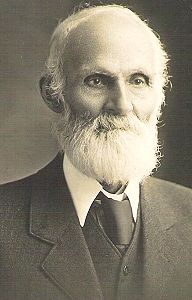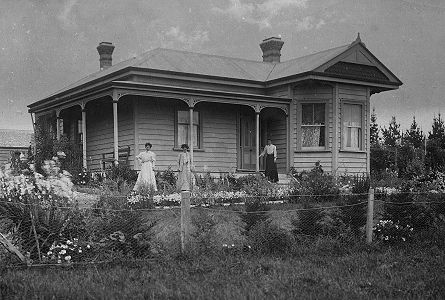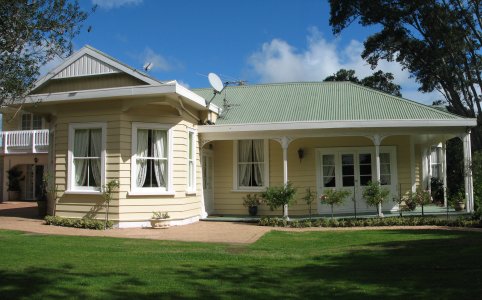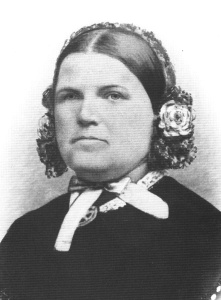| |
| The Hoskings |
Hosking Tree |
|
|
| |
|
From the local standpoint, the connection with the Hoskings began when Caleb Hosking arrived in NZ from England in 1855. This was something of an adventure in itself, but first a little bit of history leading up to this. There was a reunion of the Hosking family in Waiuku on March 12, 2005 to celebrate the 150th anniversary of the arrival of Caleb Hosking in NZ. Quite a bit of research preceded the event, and a great deal more followed, after it was decided to compile a book on the local family history. Many decendents of Caleb worked on this, including myself, and it is from this book that I draw the bulk of the early history. I must acknowledge Nola and Nigel Smith who were responsible for so much of the research and compilation of this material. |
 |
Sometime around 1938 Charles Hosking, Caleb’s elder son, was asked to burn a sackful of old books at the family property, Fernleigh. When he tipped them out one fell open at a chapter headed ‘The Burning of the Polar Star’. He instantly rescued it and treasured it all his life for his father, and other family members were on that ill-fated ship bound for New Zealand in October 1854. Nineteenth century settler voyages are full of misadventure and privation but few can match the tale of the Polar Star. Twenty-two days out from London, in the southern Atlantic Ocean ‘at half past eight one Lord’s day morning, the cry of “fire, fire!” was heard’. The hold was ablaze and despite desperate fire-fighting efforts all that could be done was to batten down the hatches and stop ‘every hole and crevice with the manure that was in the horse-box’.
The fire was to smoulder on for three days as the passengers huddled on the open deck, lashed by heavy seas. The Polar Star then drifted helplessly away from the main shipping lanes. With only minimal food and water available the only unanswered question seemed to be whether they would die by burning, drowning or starvation. Miraculously a sail then appeared on the horizon as the Hanza Mooka came to their rescue. Not a moment too soon the women and children were transferred by long boat through mountainous seas. The following morning the menfolk also abandoned ship ‘escaping from the flames that now raced with fury along the main deck and along the rigging’. Within a few minutes the vessel was aflame from stem to stern. |
| |
The Hanza Mooka then transferred the passengers and crew of the Polar Star to the remote island of St Helena, where Napoleon Bonaparte had been exiled. It would have been a journey distinctly lacking in creature comforts for the Hanza Mooka was transporting a cargo of guano from Peru to Spain – but they were in no position to be picky. After a week or so they took the first available transport out of St Helena and, just prior to Christmas 1854, Caleb was back safe and sound in his homeland - but most of his worldly goods were at the bottom of the south Atlantic. At this stage Caleb must have been tempted to abandon all thoughts of New Zealand and quietly return to Kingsbridge, Devon where he was born 22 years previously on 15th October 1832, the fifth of six children to John and Ann Hosking. |
He was baptised in the Ebenezer Wesleyan Methodist Chapel on Kingsbridge’s steep High Street - the start of a lifelong commitment to the principles and dictates of Methodism. Then, according to his entry in the Cyclopedia of New Zealand, ‘he was brought up to farming.’ But that brief phrase almost certainly glosses over the family and financial difficulties of the time. John Hosking, a wheelwright, died aged 50 in 1847 of marasmus - literally wasting away. Quite possibly cancer would be the modern diagnosis. It seems likely that he would have been unable to work for some years previously. Certainly a welter of teenaged boys were left to find their way through an uncertain economic climate. Here their uncle Charles Trick consolidates a position firmly centre-stage in the boys’ lives. The family connection had obviously always been strong. John and Ann’s eldest son was named after him. The 1841 UK census shows the second son, Richard, living with his uncle who was a miller at Ashford Mill, Aveton Gifford, about five kilometres outside Kingsbridge. |
By the time of the 1851 census both Charles Trick Hosking and Caleb Hosking are working as millers for their uncle, who is also recorded as farming 35 acres at that time. Completing a household were another miller, two farm labourers and a housekeeper – one Mary J Scott, a family cousin from St. Juliot in Cornwall. Romance soon flourished with Charles Trick Hosking and the couple were married in 1854. There was to be no going back to the old life in Devon, however. Protracted negotiations were undertaken with owners of the Polar Star regarding a new passage to New Zealand. Initially the company demanded a second fare but ‘after great trouble with the [shipping] company…the passengers arranged that by paying half the ordinary fare they should be carried to their original destination’. A voyage was arranged on the 598 ton clipper Rock City. This time we do have a passenger list which includes Caleb, Mr & Mrs Charles Hosking and Charles Trick. Indeed, it made obvious sense for them all to emigrate as a unit - they had very firm family ties, expertise as millers and, in the case of Charles Trick, presumably some capital from the sale of the mill and the farm. These ties were to remain the cornerstone of their early days in their new homeland. |
| |
Rock City sailed on March 6th, 1855 and, in complete contrast to their previous debacle, arrived in Auckland in a then-record time of 88 days. It would have been swifter still but, ironically, the ship was becalmed in ‘light and baffling winds’ off the coast of Brazil. It may well have been a relatively enjoyable experience all round for the Rock City was a new ship mainly carrying a mixed cargo and with a complement of just 17 passengers. Rock City arrived in Auckland on June 4th 1855 and remained in the port for several weeks discharging cargo for the merchants and manufacturers of the city - coal, wines and spirits and salt for Brown & Campbell; iron bars for John Watson and for Gilfillan, Stevenson & Co and a variety of goods for D Nathan. There would have been plenty of time to take a good look at a thriving city that had grown from nothing to a population of 10,000 in just 15 years. But the Hoskings seem not to have lingered. Perhaps land prices were too high. Perhaps the call of friends and countrymen in Taranaki was greater, but in any case they all reboarded the Rock City and sailed for New Plymouth, arriving on 24th July 1855. Sadly, land troubles between Maori and Pakeha had bedevilled New Plymouth since foundation. In 1855 matters started coming to a head. A local militia was in the process of being formed as they arrived. The Hoskings moved on yet again, though Caleb’s exact whereabouts become somewhat unclear over the next few years. |
Certainly the Waiuku area was of interest. Together with his brother and uncle he applied for a land grant of 466 acres in the Waiuku block (southern portion) in 1856. But, at ten shillings per acre, the blocks were attractively priced and they were not the only interested parties. Out of a total of 97 applicants only 34 were successful and the Hoskings missed out. Charles Trick and Charles Trick Hosking were actively engaged at that time building the Waitemata flourmill for John Brigham at Riverhead. They then operated the mill for a few years but do not seem to have owned it. There is no evidence that Caleb was with them at this time though it remains a possibility. By 1860 both Charles Trick and Charles Trick Hosking were residing in the Freemans Bay area of Auckland – whether separately or together is unclear – and it was in his brother’s house that Caleb married his first wife Rhoda Scott on 28th November 1860. Given that Rhoda was the sister of Charles Trick Hosking’s wife Mary Jane this was an entirely appropriate venue. A daughter, Sarah Ann, arrived on 28th September 1861 but only survived for just over a year. Since she is buried in Waiuku cemetery it is probably safe to assume Caleb had established residence in the town by this time although there is no conclusive evidence of this. There is also evidence of a Hosking presence in Waiuku in Charles Trick’s will of 1861 that leaves his two Waiuku allotments to Charles Trick Hosking. Two hundred pounds was also bequeathed to Caleb. Charles Trick died in late 1862 and this amount would have been very useful in either purchasing a farm, or repaying a mortgage and buying stock if he already owned one. |
| |
Breaking in the farm was an exacting proposition. The district ‘was then in its native state but he was not deterred by its unpromising appearance and after considerable hardship…he cleared his property of bush and scrub’. Moreover, the Land Wars continued to fester and at one stage came within a few kilometres of the town. There are reports that Caleb witnessed the shooting of a Maori near Mauku at this time. By 1866, however, Caleb seems to have been firmly established on his 60-80 acre farm originally bordered by Cornwall Road, Kitchener Road and Collingwood Road. In May that year he is reported to have carried Norfolk Island pine seedlings on foot from Auckland and planted them on his property. One tree was later struck by lightning but the other adorns the area to this day. A two-storey farmhouse was built and the farm developed on fairly traditional nineteenth century kiwi lines. A small herd of cows were milked by hand and the milk carted by wagon to the nearby dairy factory. As well as the dairy there was a pigsty, a smoke house and a salt house.
|
On July 4 1871 Caleb married Sophia Barriball at the home of her parents. They remained together until Caleb’s death in 1918, raising nine children all of whom survived the rigours of a Victorian childhood with eight carrying on into a healthy old age. Socially Caleb and Sophia were pillars of Wesley Methodist Church and are recalled for their generous hospitality to visiting preachers. They also hosted New Year’s picnics ‘in a picturesque setting in a paddock with a semi-circle of lovely native bush. Here all the farmers and families gathered for sports, lolly scrambles and swings for children’. They also ‘gave good service in the cause of temperance’. Caleb was heavily committed to the development of the infrastructure of the area. He was a long-serving member of the local road board (where he was chairman for three years) and chaired the first meeting of the Aka Aka drainage board. He also served on a local school board.
Photo at right:
Back row: Charles, Mary, Sophia, Elsie, Linda
Front row: William, Caleb, Jessica, Sophia, Edith, Clara
|
|

Caleb Hosking family at Fernleigh circa 1893 |
Around 1908 Caleb and Sophia sold Fernleigh to their son Charles and moved to nearby Parkville, a ten acre property on what is now Kitchener Road. It is here, in the final ten years of a long life, that we can build up a tentative character sketch of Caleb. Quiet, gentle, unassuming and attentive are adjectives frequently used in anecdotes about him. For instance his daughters-in-law (Bea at Fernleigh and Ethel who lived next to Parkville) regarded him with great affection, particularly valuing long chats with him on the back doorsteps of their homes. Often his children and grandchildren visited Parkville where they would talk to the old man in a cluster of seats gathered around two Karaka trees.
The house is still there. It has been renovated and added to, but the front is still quite recognisable, even though it has been photographed from the other side. It was the venue for the book launch in March 2007
|

Parkville. Out front are Edie, Clara and Elsie
|

The house in March 2007. Photo by Laurie Sanders
|
| Caleb was probably also a cautious man. For instance, he did not like his teenage sons to stay out at night - not that this stopped such strong characters as Charlie and Bill. Nor did he much like horses - which again was not passed on to the boys. Further insight into a thoroughly common sense individual comes in three surviving letters from Caleb to Lawrence and Jessie Gane written in the years immediately prior to the First World War when he was aged about 80. In one letter he commiserates with the Ganes who, on returning from a trip, had encountered some form of domestic disaster: It is almost to be expected ‘that something goes wrong if one leaves home for any length of time’, says the old man. With a touch of irony he adds, ‘I hope the pigs you lost were on the small side or the loss will not be very pleasant for you’. After his adventures getting to New Zealand, travel probably had little appeal to Caleb in later life. In another letter Caleb comments on an acquaintance who is in hospital and who ‘has not looked well for a long time. He is a heavy smoker and that is a never failing source of trouble. The pity of it is that smokers do not realise this until the mischief is done’. This judgement would not necessarily have been commonplace at the time but it certainly resonates a century later. Moreover, if this was Caleb’s opinion of heavy smokers it is perhaps just as well we do not have written testimony to his thoughts on heavy drinkers! |
A third letter reveals his continuing interest in business matters. Both the Hoskings and the Ganes, who were recently married and breaking in a farm in the Waikato, were shareholders in the New Zealand Dairy Association formed in Pukekohe by Wesley Spragg. Caleb and Wesley - an exemplary employer, prominent non-conformist layman and firm temperance advocate - had much in common and Caleb is very supportive of him in his letter. Firstly Caleb canvasses the Ganes’ vote for Spragg’s man for a vacancy to the Board of Directors: ‘[He] was with us on Tuesday. We are pleased with him…’ Then Caleb is at pains to explain the reasons for a recent increase in director’s fees to 50 pounds per annum. This is obviously a matter of friction between the various parties. But, he writes, ‘…when we consider the magnitude of the Company today [it had 2200 shareholders at that time] and compare it with what it was when the first directors were appointed this is really a very small matter’. It is the letter of a man still firm in his opinions and judgement of character yet able to accept that progress is desirable and that success deserves material reward. After a life of sometimes un-wished-for adventure, much hard work and an unfailing commitment to family and Church values, Caleb finally died on 7th June 1918 and was buried in Waiuku cemetery. In one of the letters previously quoted he made a comment after attending a funeral. He would no doubt have fully accepted it for himself: ‘…We must meekly submit to the divine will, which is too wise to err, too good to be unkind’. |
As you have read, Caleb's first wife Rhoda died, and he later married Sophia Barriball, third child and eldest daughter of Charles and Ann (nee Martyn) from North Tamerton in Cornwall. Sophia was only 18 months old when they emigrated to NZ. She was an imposing woman, and Dad recalls being quite frighted of her. Sophia seems to have got her looks from her mother. Clara fortunately did not. |
Here we take a short side road to visit the Barriballs.
Well, as you can see, Charles and Ann Barriball were a serious looking pair, and don't quite look to be the life of the party. Charles was a tall, solidly built sort of guy, while Ann was a little short thing. Both were strict Methodists.
Charles Barriball's brother Henry and his wife Mary came to NZ a year before Charles and Ann. They had settled in Taranaki, new home to quite a number of immigrants from the West Country, and perhaps their correspondence had helped Charles decide to follow. Charles and Ann sailed from Plymouth with their three children on The Duke of Westminster, on December 4, 1842. They arrived in Auckland on April 1, 1843, a voyage of 128 days, a little longer than usual. Instead of continuing on to New Plymouth, they settled in Auckland, farming land in Mt Eden owned by a Methodist Minister, the Rev. Lawry, who not being short of a few bob had bought six of the 20 acre allotments on offer.
|
|

Ann Barriball nee Martyn |

Charles Barriball |
|
It was 1856 before the family purchased 145 acres of land in Waiuku, and Charles set about clearing it for farming while his oldest son John continued farming the block in Mt Eden. An additional 442 acres were added eight months later, in the area now known as Pukeoware. He called the farm "Eden Hill". There is a road named after Charles in the place where the original farm was. Six more children had been born at the family home (called Eden Grove) in Mt Eden, bring the number of kids to nine. Although he later sold off or gifted some land to family members, Charles continued farming in the district. He died in 1880 from heart disease. Ann died five years later of "old age", at 71. Charles and Ann are buied at Waiuku cemetery.
Some of the information on the Charles Barriball family, and the photos of Ann and Charles were obtained from the book "Werrington to Waiuku - A History of the Barriballs of Waiuku" compiled by Joanne Robinson.
|
| Clara Ethel Hosking |
My paternal grandmother Clara Hosking was the sixth child of Caleb and Sophia Hosking (nee Barriball) and she was born on 26 January 1882 at Fernleigh, the family home in Waiuku. Caleb is reported as saying that she was a real beauty, and the best of the bunch, which must have gone down well with her siblings! She commenced school at Pukeoware, but at age 12 was sent to Thames to live with an aunt and uncle. This was not an uncommon practice at the time. She attended Parawai School and in 1894 was awarded a special book prize (Robinson Crusoe) for having the best kept exercise book. As well as helping her aunt and uncle, she often helped out her sister Mary with her boys, Ray and Vic. |
|
| Clara met her future husband Arthur Healey in 1901, when he was working at Fernleigh. Her story continues now with the Healeys. |
| |
|
|
| |
|